Oberlin Alumni Magazine
Spring 2010 Vol. 105 No. 3
A Scientific Culture
Oberlin’s approach to the study of science
yields real results
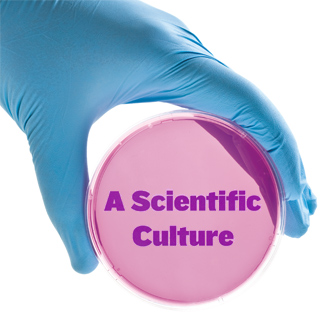
Ask faculty and administrators what accounts for Oberlin’s strength in the sciences and they invariably will answer: the students. Ask students and most will tell you "the chance to work closely with the faculty." That’s what scientists—and a lot of others—call symbiosis, and it runs throughout the sciences at Oberlin, where the culture, and even the architecture, foster collaboration between students and faculty, between generations of faculty, and between disciplines.
"There’s something about Oberlin students’ creativity and openness to studying outside the sciences that is different even from other liberal arts colleges," notes Sean Decatur, professor of chemistry and dean of Oberlin’s College of Arts and Sciences. "We see it anecdotally in the number of double-degree [college and conservatory] and double-major students with the other major outside the sciences. We attract students who want to bridge the left-brain, right-brain gap."
Adds Manish Mehta, associate professor of chemistry, "My students are all academically inclined, serious about their study, so I can push them in the classroom and the lab. Also, there isn’t a culture of grade mongering. I hear horror stories from other places of students threatening to sue their teachers, and I don’t have to worry about that here. It makes for a great environment to be a teacher and a researcher."
The college reaffirmed its commitment to the sciences with construction of a $55 million Science Center, the largest capital project in college history. Opened in 2002, it unites the physics, chemistry, biology, and neuroscience departments under one roof and includes a science library, classroom space and lecture halls, lab space for every faculty member, and numerous alcoves and common areas where students can study together or just hang out.
An additional advantage of housing departments together is that it makes it easier to share sophisticated—and expensive—equipment, including supercomputing facilities, a confocal microscope, and a scanning electron microscope.
The strength of the sciences at Oberlin today is best illustrated through the work of its faculty. While their backgrounds and the nature of the work vary widely, they have certain traits in common: Most were themselves educated at small liberal arts colleges, where they saw the benefits of hands-on research and close interaction with their professors. They have high regard for their students. Perhaps most important, they are passionate about both their research and teaching, and believe that they reinforce each other.
Further proof of the high quality of science practiced and taught at the college is its success in securing federal grants to support research and purchase equipment. The Department of Chemistry, for example, has more than $1 million in research grants from the National Science Foundation (NSF), a large amount relative to the size of the department and institution.
Everyone living in or near a major city knows about ozone alerts —those humid summer days when the air seems to turn opaque and people with breathing problems are warned to stay indoors. Matthew Elrod, associate professor and chair of the chemistry department, studies the process by which ozone gets formed in the atmosphere. His work focuses on a particular class of chemical compounds, known as aromatics, found in numerous everyday products from gasoline to oil-based paints.
"Basically what we do is take these [aromatics] through the kind of chemical reactions that would happen in the atmosphere," Elrod explains. "And this class of chemicals is incredibly reactive. We’ve been very excited lately to see all the crazy stuff going on with these relatively simple molecules." The results of his work, he adds, help the Environmental Protection Agency reduce ozone levels in the atmosphere. His research is funded through a three-year, $400,000 NSF grant.
Elrod began at Oberlin in the fall of 2001. ("My second day of class was 9/11.") Being able to teach and do research, he says, makes him better at both. "Doing research inevitably moves you into areas you don’t know much about yourself. And that helps put you in the shoes of your students, in that you’re constantly reminded of what it feels like not to know what’s going on. Plus there’s the advantage that you can tell your students about something really cool that’s not in the textbook.
"At the same time, teaching at a place like Oberlin benefits research, because we have to teach courses that aren’t directly in our area of expertise. That’s caused me to learn things I never would have looked into, and realize later on they can help me in my research."
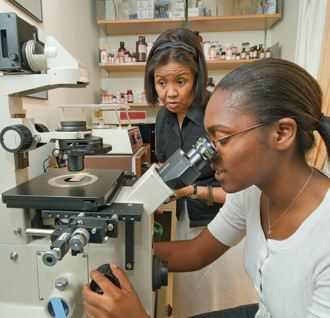 Yolanda Cruz in her lab with Ria Richards ’09. (photo by Kevin Reeves)
Yolanda Cruz in her lab with Ria Richards ’09. (photo by Kevin Reeves)
Yolanda Cruz, the Robert S. Danforth Professor of Biology, arrived in Oberlin in 1986 after a journey that began in her native Philippines. Her intellectual journey began with an interest in parasitic wasp reproduction, continued to mouse embryos, and currently focuses on the development of marsupial embryos.
She had seen the quantity of research emanating from the large mouse labs at many research universities and medical centers. She figured there would be more opportunities outside of mice and decided to study marsupial embryos instead, thus putting herself among only a handful of North American experts in the field.
Cruz’s current research focuses on embryonic stem cells in opossums, looking for clues as to why marsupials differ in their embryonic development from the so-called placental mammals, a group that includes humans and most other common forms of mammals. Her work is funded with a $300,000 NSF grant.
"What I find appealing is the excitement of discovering things that are essentially new all the time, because there aren’t many people working on this," she explains. There’s also a practical aspect to her work. "When these babies are born they are very immature, like a human baby being born at three months, but healthy. So it is a good way to study, for example, the development of the nervous system and various organs."
While Cruz had job opportunities at other colleges and universities, they would have required her to focus either on teaching or research, she says, and she couldn’t stand the thought of giving up either. "My research keeps me up to date in the field, and I love sharing the students’ excitement that comes with teaching. It’s the face that erupts into a bright smile and goes, ‘Oh my gosh, no one has ever known this before? We discovered this?’ I can’t put a price tag on that."
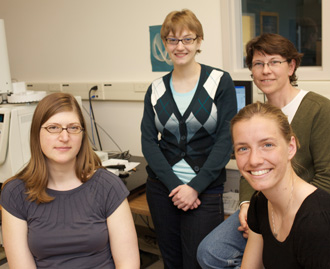 Clockwise from top: Amy Austin ’11, Mary Garvin, Clara Shaw ‘10 and Rebecca Whelan, cross-disciplinary, cross-generational collaborators. (photo by John Seyfried)
Clockwise from top: Amy Austin ’11, Mary Garvin, Clara Shaw ‘10 and Rebecca Whelan, cross-disciplinary, cross-generational collaborators. (photo by John Seyfried)
The work of Rebecca Whelan and Mary Garvin illustrates how the Science Center promotes collaboration within and between scientific disciplines. Whelan, assistant professor of chemistry, and Garvin, the D.R. Longman Associate Professor of Biology, have been jointly studying how chemical cues may be important in disease transmission.
Whelan and Garvin were brought together by biology and biochemistry major Tera Levin ’07, now a doctoral candidate and NSF pre-doctoral fellow in cellular and molecular biology at UC-Berkeley. While concurrently enrolled in Whelan’s analytical chemistry course and Garvin’s community ecology course, Levin realized that she had the means to answer the question of why disease-carrying insects bite some species of birds and not others.
"Tera came to each of us independently and asked what we would think if she did this project with one foot in chemistry and one in biology. She brought this collaboration together," Garvin recalls.
Four years later, the collaboration is still going strong. With the help of nine students in Garvin’s lab and two in Whelan’s, the professors are testing various chemical compounds found in birds to see if they attract or repel mosquitoes that transmit disease and bacteria that degrade bird feathers. The students and professors meet weekly to exchange information and discuss problems encountered in their research. The first paper resulting from their collaboration, coauthored with Levin, has been accepted for publication in the Journal of Comparative Biochemistry and Physiology. The second paper, based on the work of Whelan’s honors student Clara Shaw ’10, is also nearing completion.
"This is a perfect example of how the building’s design and layout fosters collaborative relationships," Whelan observes. "It might still work in a scenario where biology and chemistry are in separate buildings, but it would be different in the quality and frequency of the interactions."
Assistant Professor of Physics Chris Martin’s research passion is the stuff of life. Specifically, the chemicals that form the basis for life—carbon, oxygen, nitrogen—that did not exist when the universe first came into being. Rather, they are formed as byproducts of the process by which stars are created, die, and are reborn.
Our own galaxy turns out to be a good place to study the process, says Martin, because these chemicals are constantly streaming from the fringes of the Milky Way toward its center. "As these big clouds of materials fall into the center of the galaxy, they get squished together and formed into new stars," he explains. "Those stars are very big, so they burn very fast, and die explosively as supernovas. And so we’re looking at materials that will become the next supernovas at the center of our galaxy." Martin heads a research team that includes representatives from Harvard and the University of Arizona, as well as universities in Germany, the Netherlands, and the United Kingdom.
Martin and his team will soon have a new platform from which to observe the process: the European Space Agency’s (ESA) Herschel Space Observatory. Launched in May 2009, the observatory orbits Earth at a distance of nearly one million miles. The ESA designated Martin’s investigation as a "Key Project" among all the groups who applied to use the observatory’s instruments. His research is funded with a $380,000 grant from NASA.
The goal of Dan Stinebring’s research is nothing less than to develop a new tool for astronomers to use in observing the universe. Stinebring, the chair and Francis D. Federighi Professor of Physics, has been studying an exotic phenomenon known as gravitational waves. These are slight fluctuations in the fabric of space-time, generated by such massive force as two stars rotating around one another or around black holes, and which move through the universe like ripples on a pond.
For Stinebring and his fellow astronomers, the value of gravitational waves is that they reveal information not available through electromagnetic waves, which have been our traditional source of information about the rest of the universe.
"When something out there happens like a star violently collapsing and blowing its outer envelope into space, a supernova, we may see some signals through electromagnetic waves, but we can’t see a lot of the inner details," Sinebring explains. "However, a lot of those details are imprinted onto the gravitational waves coming out. So if we can learn to ‘read’ those waves, it’s like we have a whole new kind of telescope. It will give us totally new ways of viewing some of the most dramatic and exotic events in the universe."
Having attended a small liberal arts college (Williams), Stinebring wanted a professional home where he could find the same opportunities for student-faculty interaction. Oberlin, he says, has provided that and a lot more. "My wife and I feel fortunate to be in a place that has world-class music, with the richness of community life and the friendships we’ve formed with other faculty members. We certainly expect to spend a long time here."
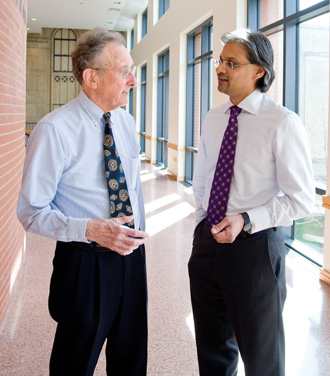 Norman Craig ’53 and Manish Mehta outside the Norman C. Craig Lecture Hall. (photo by Nannette Bedway)
Norman Craig ’53 and Manish Mehta outside the Norman C. Craig Lecture Hall. (photo by Nannette Bedway)
When Manish Mehta came to Oberlin in 1998, he faced a challenge common to many new science faculty members at liberal arts colleges: to find, as he puts it, "a research question of interest to me that could be done with undergraduates, was original, fundable, and would not compete with the big labs."
Mehta, an associate professor of chemistry, decided to use his postdoctoral training in nuclear magnetic resonance (NMR) imaging to study how the shapes of very small proteins are influenced by their surrounding environment. That, he explains, is a small piece of a larger question chemists have been studying for a long time: how does a linear string of amino acids, which are the building blocks of proteins, "fold" into the three-dimensional shape that enables the protein to perform its primary function of catalyzing a chemical reaction?
To conduct his research, Mehta obtained NSF grants to purchase sophisticated instruments, including the only 600-megahertz nuclear magnetic resonance spectrometer to exist at a liberal arts college. "It really is a tremendous thing that our undergrads can get hands-on experience with cutting-edge equipment like this," he says. "It leapfrogged us ahead of our peer institutions." His teaching and research have earned him a $500,000 grant from the NSF’s Faculty Early Career Development Program, and a $60,000 Teacher-Scholar Award from the Camille and Henry Dreyfus Foundation.
Mehta credits much of his success as a teacher to his association with Emeritus Professor of Chemistry Norman C. Craig ’53, with whom his career has been closely intertwined. Mehta first came to Oberlin as a sabbatical replacement for Craig in 1993. "For half of that sabbatical year Norm was in Oberlin, which was terrific for me as a first-time teacher," he recalls. "I had full access to his teaching materials and to him. We had many conversations about thermodynamics and about teaching in general, and I learned a great deal from those interactions."
A few years later, when Craig announced plans to retire from teaching, Mehta was hired to fill the impending vacancy. They team-taught a chemistry course in the spring of 2000, the last semester before Craig retired. (Mehta also taught an earlier course with Terry Carlton, now also an emeritus professor.) "Those interactions between junior and senior colleagues, in the context of team teaching, provided valuable opportunities for professional growth in the early years," he says.
The relationship between the pair has been made even stronger by physical proximity: They are next-door neighbors in both their Oak Street homes and their offices in the Science Center.
If there is an institutional memory for science education at Oberlin, it resides in the person of Norman Craig. His association with Oberlin science dates to the early 1950s, when he was a student at the college, majoring in chemistry. After earning a PhD at Harvard he joined the Oberlin faculty in 1957 and was present for the opening of Kettering Hall in 1961, an event he sees as a watershed in the sciences at Oberlin.
"Kettering contained an unusually large number of laboratory spaces, which made it possible to do research in a more vigorous way. Among other things it meant that people no longer went away as much during the summer but stayed to do research. So in some sense what you see with the new Science Center is a continuation of that."
Craig’s own research focuses on better understanding the basic structure of molecules. "Chemists believe that if you know the structure of a molecule, particularly the lengths and angles and shapes of the bonds that hold it together, you can make sense out of its properties and the way it reacts with other molecules or in solvents," he explains.
In the last decade or so new developments in spectroscopy have enabled Craig and others in the field to view chemical bonds of lengths never before possible–down to 1/1000 of an angstrom. (One angstrom equals 0.1 nanometers, or 1 × 10−10 meters.) Craig performs his research with scientists at the U.S. Department of Energy’s Pacific Northwest National Laboratory, home to some of the world’s most powerful spectrometers.
The advances in technology coincided with Craig’s transition to an emeritus professor in 2000. Since then he has funded his research through a series of $20,000 grants from the Dreyfus Foundation’s Senior Scientist Mentor Program, used to pay summer stipends to students.
Craig’s longevity and experience also enable him to informally mentor younger faculty members in ways such as loaning his lecture notes or suggesting promising areas of research or places to seek funding. "Norm avails himself to anyone who knocks on his door and he is always generous with his time," Mehta observes. "I have taken advantage or his wealth of knowledge and experience over the years, and as I have grown into my role I have come to appreciate his insights more and more."
Craig is often asked what changes he has seen at Oberlin since 1949, the year he enrolled as an undergraduate. While there have been many changes, Craig says he prefers to emphasize the constants. "The way to think about Oberlin is that it’s intellectually elite, but it’s socially egalitarian, and it’s morally sensitive. I believe that’s a pretty good description that has held up over time."
Jeffey Bendix, is a writer living in Cleveland Heights, Ohio.
Manish Mehta recently spoke to a group of academic deans from the country’s top colleges and universities on the importance of advising among the many duties assigned to professors. A transcript of his remarks is available through our web extras.
There you’ll also find the essay "Norm Craig’s Shoes," an appreciation written by Mehta about his mentor and friend.
Robel Winner Credits Nobel Winner
In the fall of 2002, while teaching in the introductory neuroscience course, I explained the exciting story behind the discovery of the protein nerve growth factor. It is a remarkable story about a significant scientific discovery, and one nearly every developmental neurobiologist recounts at some time. I also pointed out (bragged actually) that the man who purified this remarkable protein, Stanley Cohen, was an Oberlin College graduate (1945) who shared the 1986 Nobel Prize for this work. Little did I know the student in the front row, writing notes throughout this discussion, was actually attending Oberlin College based on the recommendation of Cohen.
Leslie Dowell Kwakye ’05 knew Cohen through their Nashville Unitarian Church. Cohen, then professor of biochemistry at Vanderbilt University, says he knew from attending Oberlin that the college had "an interest in improved educational opportunities for women and minorities." He also recognized that Leslie was very bright.
When Dowell Kwakye visited Oberlin, she fell in love with the relaxed, open-minded atmosphere. "The one thing that makes Oberlin so special is its stellar science education," she says. "It was perfect to find a school with a great neuroscience program and a great atmosphere." At Oberlin, she excelled as a neuroscience major, winning the neuroscience department’s Robel Prize for academic excellence and potential for graduate work. She also won the national Goldwater Scholarship. Dowell Kwakye is now a doctoral student in neuroscience at Vanderbilt University, where she investigates temporal processing in autistic spectrum disorders and continues to win awards and research support.
Cohen was pleased to hear of Dowell Kwakye’s success. "Not all of my suggestions work out as well," the Nobel laureate says.
Undergraduate research opportunities abound at Oberlin
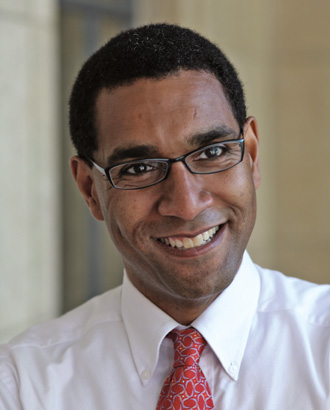 (photo by John Seyfried)
(photo by John Seyfried)
Independent, creative work. Close interaction with faculty. Experiences that move education beyond the traditional classroom. These are all hallmarks of the Oberlin education experience and all part of the student-faculty research experience. Many generations of Obies majoring in the sciences have worked directly with Oberlin faculty on research projects throughout the natural sciences. These collaborations have resulted in papers published in peer-reviewed journals, opportunities for students to present their first poster or talk at an academic conference, and experiences that help prepare students for future success not only in graduate or professional schools, but in any professional career path they choose. They have also resulted in national recognition for the students.
In early April, the Barry M. Goldwater Scholarship and Excellence in Education Program named Lisa Goddard ’11 and Jaie Woodard ’11 Goldwater Scholars, and also recognized Ben Jakubowski ’11 as an honorable mention selection.
One of last year’s Goldwater awardees, Jamie Wagner ’10, has continued to garner scientific prizes. At the annual Experimental Biology meeting in California at the end of April, the biology/neuroscience major was awarded a David S. Bruce Award for Excellence in Undergraduate Research, an annual prize of the American Physiological Society. Jamie’s trip to this meeting was completely funded by a travel award from the Ohio Physiological Society given in recognition of an excellent oral presentation at their meeting.
Jamie works closely with Maureen Peters, assistant professor of biology, whose lab uses roundworms (C. elegans) to investigate how organisms coordinate the timing of digestive muscle contractions. Jamie’s research focuses on the role of charged hydrogen ions, protons, in this process.
"Jamie is a dedicated, talented, and enthusiastic student researcher who really embodies the best of undergraduate research at a liberal arts college," says Peters. "She’s been an integral part of my project, intimately involved in all stages of the research process: experimental design, execution, analysis of data, and presentation in oral and graphic form."
As Jamie’s experience shows, science at Oberlin goes well beyond classroom lectures, and even beyond the school calendar. Undergraduate research is a year-round enterprise at Oberlin, with many students undertaking research with faculty on a credit basis during the academic year or winter term, or as paid assistants during the summer. Each year, 120 to 130 students spend the summer on campus collaborating with faculty on research. These positions are supported by faculty research grants from such diverse funding agencies as the National Science Foundation, Research Corporation for Scientific Advancement, the National Aeronautics and Space Administration, and the Camille and Henry Dreyfus Foundation, as well as by awards from Oberlin’s competitive internal grants program. Additional support for student-faculty research is provided by the Mellon Mays Undergraduate Fellowship Program, funded by grants from the Andrew W. Mellon Foundation, and by the Oberlin College Research Fellows Program. These two programs provide two-year mentored research experiences to underrepresented, first-generation college, and low-income students, preparing them for graduate school and academic careers while fostering the development of a more diverse faculty in the U.S.
The model of student-faculty collaboration has extended beyond the natural sciences, with faculty and students from arts and humanities and the social sciences participating in greater numbers each year, in fields ranging from classics to politics and mathematics. Faculty interest in working with student researchers has never been higher, with applications for summer 2010 assistantships through the college’s internal grant competitions almost double the amount of available funding. To help meet this need for more opportunities for collaborative work by students and faculty, the Andrew W. Mellon Foundation awarded Oberlin a $500,000 grant for collaborative student-faculty research. The grant—to be matched on a 2-to-1 basis by new gifts—will create an endowment of $1,500,000 to insure that this valuable experience will continue to be a part of an Oberlin education and available to more students.
